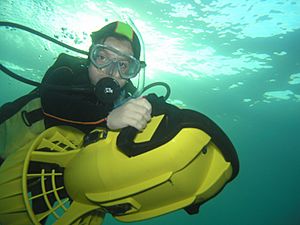Diving scooter facts for kids
A diver propulsion vehicle (DPV) is like an underwater scooter for scuba divers! It's also called an underwater scooter or sea scooter. Divers use DPVs to move faster and travel further underwater. Imagine being able to explore more of a coral reef or a sunken ship without getting tired!
Normally, divers can only go so far because they have a limited amount of breathing gas (the air they breathe). DPVs help save energy, so divers use less air and can cover more distance. They also help divers deal with time limits underwater, especially on deeper dives.
DPVs come in different sizes. Some are small and easy to carry, perfect for fun dives. Others are larger and more powerful, designed to carry several divers or heavy gear over long distances. The very first DPVs were used during World War II for military missions.
Contents
How a DPV Works
A DPV is usually a strong, waterproof case that holds a battery and an electric motor. This motor spins a propeller that pushes the diver through the water.
DPVs are designed to be safe. The propeller is usually covered so it doesn't accidentally hurt the diver, their equipment, or marine life. They also have safety features to prevent them from starting by accident or swimming away from the diver. When a DPV is underwater, it's designed to be almost perfectly balanced, meaning it doesn't float up or sink down easily. This is called being neutrally buoyant.
What DPVs are Used For
DPVs are super helpful for divers who want to explore more!
Exploring Underwater Caves and Wrecks
One of the main uses for DPVs is in cave diving or exploring large shipwrecks. These places can be very big, and swimming through them can take a lot of time and effort. A DPV allows divers to cover long distances quickly, saving their energy and precious underwater time. They can also help divers carry bulky equipment more easily.
Longer and Deeper Dives
On deep dives, divers have to be careful about how long they stay underwater because of something called decompression. DPVs help divers move efficiently, which means they use less energy and breathe less air. This can help them manage their dive time better and make their dives safer.
Special Missions
Sometimes, special divers, like those in the military, use DPVs to carry themselves and their gear over long distances underwater. This helps them get to their mission areas without getting tired.
Adding Accessories
Divers can attach cool accessories to their DPVs, like bright lights for dark areas, compasses for navigation, or even video cameras to record their underwater adventures!
See also
 In Spanish: Vehículo de propulsión para buceo para niños
In Spanish: Vehículo de propulsión para buceo para niños




